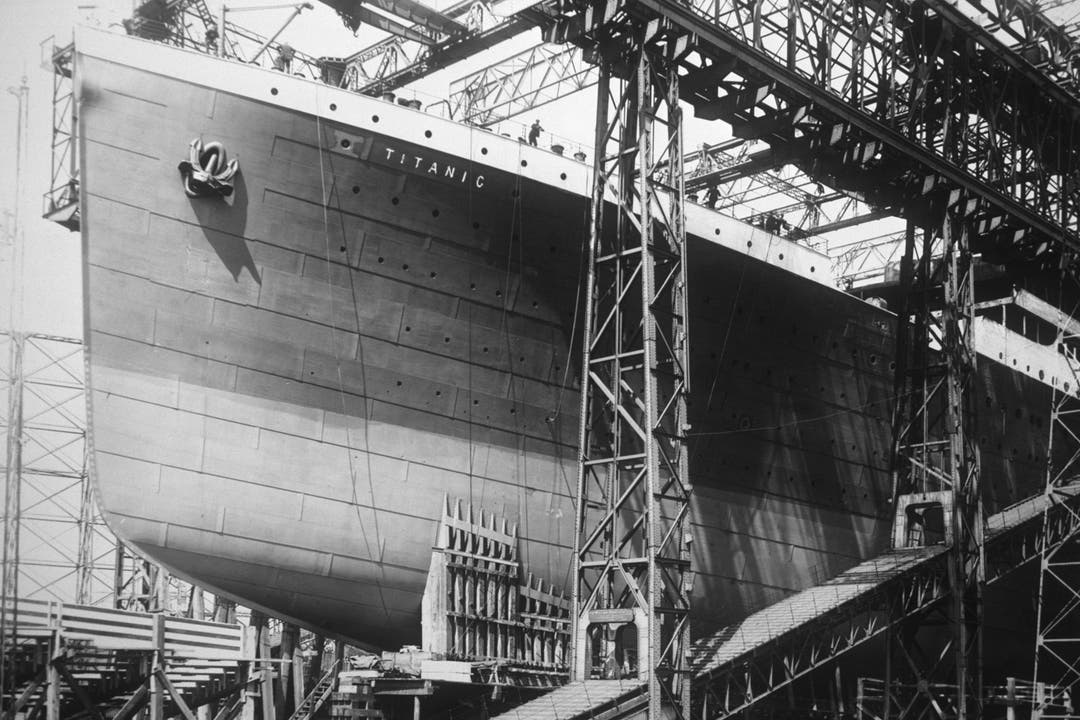In 1985, a joint American-French expedition tracked down one of the biggest prizes in maritime archeology: the 73-year-old wreck of the ‘unsinkable’ ocean liner Titanic.
 RALPH WHITE/GETTY IMAGES
RALPH WHITE/GETTY IMAGES
Dr. Robert Ballard couldn’t sleep. It was the early morning of September 1, 1985, and the 43-year-old oceanographer was lying in his bunk aboard the research vessel Knorr. Ballard had led the ship to the North Atlantic in search of the long-lost wreck of Titanic, but despite combing the seafloor for more than a week, his team’s camera-outfitted robot had yet to find anything other than miles of sand and sediment. With only a few days left before the mission ended, he was beginning to worry the iconic “Ship of Dreams” might never be found.
The Discovery of the Titanic Wreck
As Ballard tried to distract himself with a book, the Knorr’s cook appeared and said the on-duty watch team had called for him. Ballard pulled a jumpsuit over his pajamas and dashed to the ship’s control van. When he arrived, his colleagues replayed what had just appeared on their robot’s live video feed of the seafloor. The footage was dim and grainy, but the metal object it showed was unmistakable: one of Titanic’s boilers. Ballard and his crew erupted with cheers and applause. Someone opened a bottle of champagne for a toast, but the mood suddenly darkened after they noticed that it was nearly 2:20 a.m.—the exact time the ocean liner had sunk and taken more than 1,500 passengers and crew to their deaths. The thought of it hit Ballard like a shock. “We were embarrassed we were celebrating,” he later told 60 Minutes. “And all of a sudden we realized that we should not be dancing on someone’s grave.”
By the time of the crew’s discovery, 73 years had passed since the Titanic left on its doomed maiden voyage to New York. After the liner sank, would-be treasure hunters had proposed using everything from electromagnets to nylon balloons to raise it from the depths. The only problem was that no one knew where it was. Titanic had continued to drift after last reporting its location in a distress call, leaving explorers with a search area that spanned hundreds of miles. Several missions had set off to look for its watery grave. All of them—including a 1977 expedition led by Ballard—had come home empty-handed.
Ballard’s second search attempt had been in the works since the early 1980s, when he asked the U.S. Navy to fund the development of the Argo, an unmanned camera sled that could be towed behind a surface ship at depths of up to 20,000 feet. The Navy balked at footing the bill for a Titanic search, but they were interested in using Ballard’s new robot to survey the wrecks of the U.S.S. Thresher and Scorpion, two nuclear submarines that had been lost in the Atlantic in the 1960s. The two parties eventually came to a compromise: if Ballard could successfully locate and map the two sunken subs, he could use whatever time he had left to look for Titanic.
A Top-Secret Expedition
Since the United States was still embroiled in the Cold War, the operation was kept top-secret. Ballard was given special instructions and put on active duty as a Naval officer, but as far as the rest of the world was concerned, he was simply an oceanographer on a search for Titanic. It wasn’t until the 2000s that the mission’s military agenda was fully declassified.
Ballard began his clandestine expedition by photographing Thresher in the summer of 1984. The following year, he and a team from the Woods Hole Oceanographic Institution returned to the Atlantic and tracked down the wreck of Scorpion off the coast of the Azores. Ballard knew the Navy mission would leave him with precious little time to seek out Titanic, so he asked the French Research Institute for Exploitation of the Sea, or IFREMER, to partner with him.
In July 1985, the French research vessel Le Suroit began scouting the area where Titanic was believed to have sunk. Using a technique known as “mowing the lawn,” expedition leader Jean-Louis Michel towed a side-scan sonar system back and forth across the search zone in the hope of detecting large metal objects on the seafloor. Despite trawling the Atlantic for five weeks, the sonar failed to uncover any promising leads. The job of finding Titanic fell to Ballard and the crew of Knorr, who had just wrapped up their survey of Scorpion.
RALPH WHITE/CORBIS/GETTY IMAGES
CONSTRUCTION OF THE TITANIC.
Ballard’s military project left him with just 12 days to look for Titanic, but it had also given him an idea for a new search technique. While photographing Thresher and Scorpion, he’d noticed that the current had carried small bits of wreckage from the ships as they fell to the seafloor, creating a long chain of debris. With this in mind, he decided not to search for Titanic’s hull. Instead, he would use Argo to scour the bottom for its much larger debris trail, which might stretch as far as a mile. Once he found it, he could use it to track down the ship itself.
The new approach allowed Ballard to expand the search area and move through it in a much wider pattern. Rather than “mowing the lawn” with sonar, he dragged Argo along the seafloor and monitored the live video feed from its onboard cameras. Seven people were needed to keep the submarine and Knorr in synch and analyze all the data, and the crew worked in shifts to keep the watch going around the clock. After several grueling days, they were rewarded with the sight of riveted hull plates and the telltale boiler. Argo continued stalking the debris trail, and the following morning, Titanic’s bow came looming out of the inky depths.
Weather Forces Hasty Work Documenting the Wreck
For Ballard, the discovery came with mixed emotions. “It was one thing to have won—to have found the ship,” he later wrote. “It was another thing to be there. That was the spooky part. I could see the Titanic as she slipped nose first into the glassy water. Around me were the ghostly shapes of the lifeboats and the piercing shouts and screams of people freezing to death in the water.” As many had long suspected, Titanic had broken in two as it sank to the bottom. Its bow sat upright and was still surprisingly intact. The more heavily damaged stern lay some 400 meters away.
Ballard and his crew scrambled to document the wreck with both Argo and Angus, another unmanned submarine designed to take still photographs. The shots revealed large sections of Titanic’s hull and mast, including the crow’s nest where the fatal iceberg had first been spotted. Several of the hatches had been torn off, and a missing skylight allowed a tantalizing glimpse down into where the ship’s “grand staircase” had once been located. The large debris field included pristine china plates, pieces of furniture and even an unopened case of champagne. Sea scavengers had long since consumed any human remains. The only remnants of the victims were the many pairs of leather shoes still lying on the sandy bottom.
Could the Titanic Disaster Have Been Avoided?
In 1912, Titanic only had 37 seconds to avoid an iceberg. Why so little time? Was it that the lookouts lacked binoculars, or that a huge ship can’t turn quickly? William Murdock investigates whether Titanic’s sinking was caused by the lookouts or the navigation team—and if Titanic’s tragedy could have been avoided.
Coroner’s Report: Titanic
When the “unsinkable” ocean liner Titanic was lost after hitting an iceberg on April 15, 1912, lifeboats saved only 700 of her passengers. What did the 1,500 people who went down with the ship experience in the icy waters of the North Atlantic?
Titanic: Stewardess Survival
This video clip from ‘What Happened After’ looks at the life of Violet Jessup, a stewardess aboard the Titanic who would ultimately become the only woman to survive the sinking of the Titanic and her sister ship, the Britannic.
Just four days after they laid eyes on Titanic, stormy weather forced the crew to pack up their supplies and steer Knorr toward home. Dozens of scientists would later study the site more thoroughly, including Ballard, who returned the following summer to get a firsthand glimpse of the wreck from inside a manned submersible called Alvin.
In the meantime, photos of the momentous discovery were splashed on the front pages of newspapers across the globe, and an army of reporters and television cameras greeted Knorr when it docked in Massachusetts. Ballard, who would later become a fierce opponent of attempts to salvage artifacts from Titanic, used his first press conference to stress the need for the wreck to be treated with reverence.
“The Titanic lies now in 13,000 feet of water on a gently sloping alpine-like countryside overlooking a small canyon below,” he said. “There is no light at this great depth and little life can be found. It is a quiet and peaceful place—and a fitting place for the remains of this greatest of sea tragedies to rest. Forever may it remain that way.”
In February 2023, 80 minutes of never-before publicly seen underwater video of the underwater discovery was released by the Woods Hole Oceanographic Institution. The footage was captured by cameras in a three-person research submersible named Alvin and the remotely operated Jason Jr. in July 1986. Ballard and two pilots were inside Alvin as the team explored the long-lost ship.






